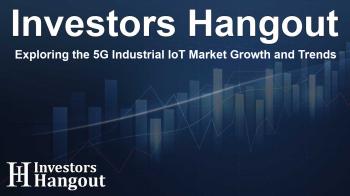Exploring the 5G Industrial IoT Market Growth and Trends

The Future of the 5G Industrial IoT Market
The global 5G Industrial IoT Market is set to experience dramatic growth, anticipated to reach USD 22.9 billion by the end of the forecasted period. This growth trajectory, characterized by a remarkable 37.24% CAGR from 2024 to 2031, signifies the escalating importance of 5G technology in shaping industrial practices.
The Role of 5G in Industrial Transformation
Industries across the board are leveraging the capabilities of the 5G Industrial IoT to revolutionize their operations. With a current valuation of approximately USD 2.24 billion, businesses are quickly realizing the benefits of enhanced connectivity, offering transformative advantages in real-time monitoring and automation.
Smart Manufacturing and Industry 4.0
One of the key drivers of this market growth is the rise of smart manufacturing, epitomized by Industry 4.0. Here, companies are moving toward automated systems that minimize downtime while maximizing operational efficiency. Companies are adopting 5G technology to install interconnected devices capable of delivering real-time data, thus enhancing their decision-making capabilities.
Importance of Low-Latency Communication
The need for ultra-reliable low-latency communication (URLLC) has never been more crucial. Industrial applications, such as autonomous machinery and augmented reality systems, demand sub-millisecond latency. This capability is where 5G shines, facilitating smooth and robust communication essential for mission-critical applications.
Key Market Insights
According to a comprehensive report by Verified Market Research, several factors underline the growth of the 5G Industrial IoT market:
- Component Segmentation: This market is segmented by component, organization size, application, end-users, and geography, allowing for tailored market strategies.
- Edge Computing Synergy: The integration of 5G with edge computing enables real-time data processing, reducing latency and fostering intelligent decision-making on production floors.
- Regional Dynamics: North America leads in the field, driven by advanced infrastructure and robust industrial automation initiatives supported by government efforts.
- Competitive Landscape: Notable companies such as Qualcomm Technologies Inc., Ericsson, Nokia, and IBM Corporation are at the forefront, strategically positioning themselves to capitalize on the emerging trends within this sector.
Challenges in 5G Industrial IoT Adoption
While the outlook for the 5G Industrial IoT market appears bright, several challenges remain:
Infrastructure and Deployment Costs
High initial infrastructure and implementation costs present a significant barrier to entry for many firms, particularly for small and medium-sized enterprises. Investing in 5G capabilities requires substantial financial commitment, which can be daunting for businesses transitioning from legacy systems.
Cybersecurity Concerns
The proliferation of IoT devices brings heightened vulnerabilities to cyber threats. As industrial sectors become increasingly digitized, the risk of data breaches and cyberattacks necessitates robust security measures. Companies must navigate these risks meticulously to ensure the integrity of their operations.
Market Opportunities and Strategic Recommendations
The perspective of the 5G Industrial IoT market is filled with opportunities for growth and innovation. To remain competitive, businesses should focus on:
- Investing in training programs for workforce adaptation to new technologies.
- Emphasizing partnerships with technology providers to ease the transition and integration of 5G capabilities.
- Prioritizing cybersecurity measures to protect their digital assets effectively.
Frequently Asked Questions
What is the projected growth of the 5G Industrial IoT market?
The 5G Industrial IoT market is expected to grow significantly, reaching USD 22.9 billion by 2031.
What are the main benefits of adopting 5G technology?
Key benefits include enhanced real-time monitoring, automation, and improved operational efficiency.
Which industries are most likely to benefit from 5G Industrial IoT?
Industries such as manufacturing, energy, logistics, and automotive are likely to see significant benefits.
What challenges do companies face in adopting 5G technology?
Challenges include high initial costs, integration complexities with legacy systems, and cybersecurity concerns.
Who are the key players in the 5G Industrial IoT market?
Major players include Qualcomm Technologies Inc., Ericsson, Nokia, and IBM Corporation, among others.
About The Author
Contact Logan Wright privately here. Or send an email with ATTN: Logan Wright as the subject to contact@investorshangout.com.
About Investors Hangout
Investors Hangout is a leading online stock forum for financial discussion and learning, offering a wide range of free tools and resources. It draws in traders of all levels, who exchange market knowledge, investigate trading tactics, and keep an eye on industry developments in real time. Featuring financial articles, stock message boards, quotes, charts, company profiles, and live news updates. Through cooperative learning and a wealth of informational resources, it helps users from novices creating their first portfolios to experts honing their techniques. Join Investors Hangout today: https://investorshangout.com/
The content of this article is based on factual, publicly available information and does not represent legal, financial, or investment advice. Investors Hangout does not offer financial advice, and the author is not a licensed financial advisor. Consult a qualified advisor before making any financial or investment decisions based on this article. This article should not be considered advice to purchase, sell, or hold any securities or other investments. If any of the material provided here is inaccurate, please contact us for corrections.

